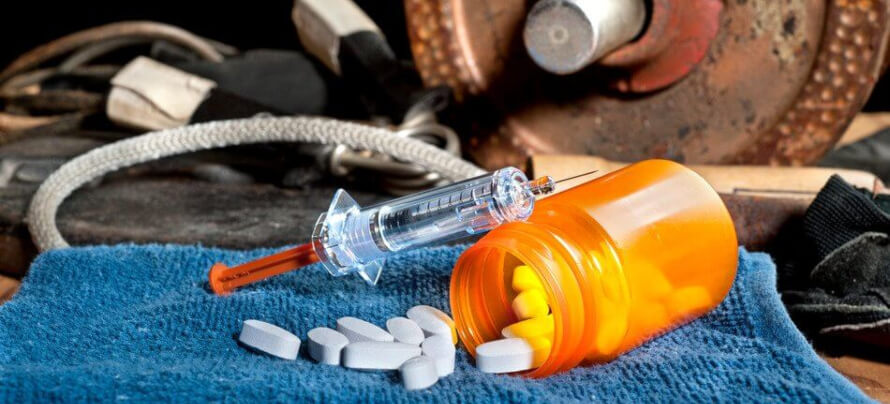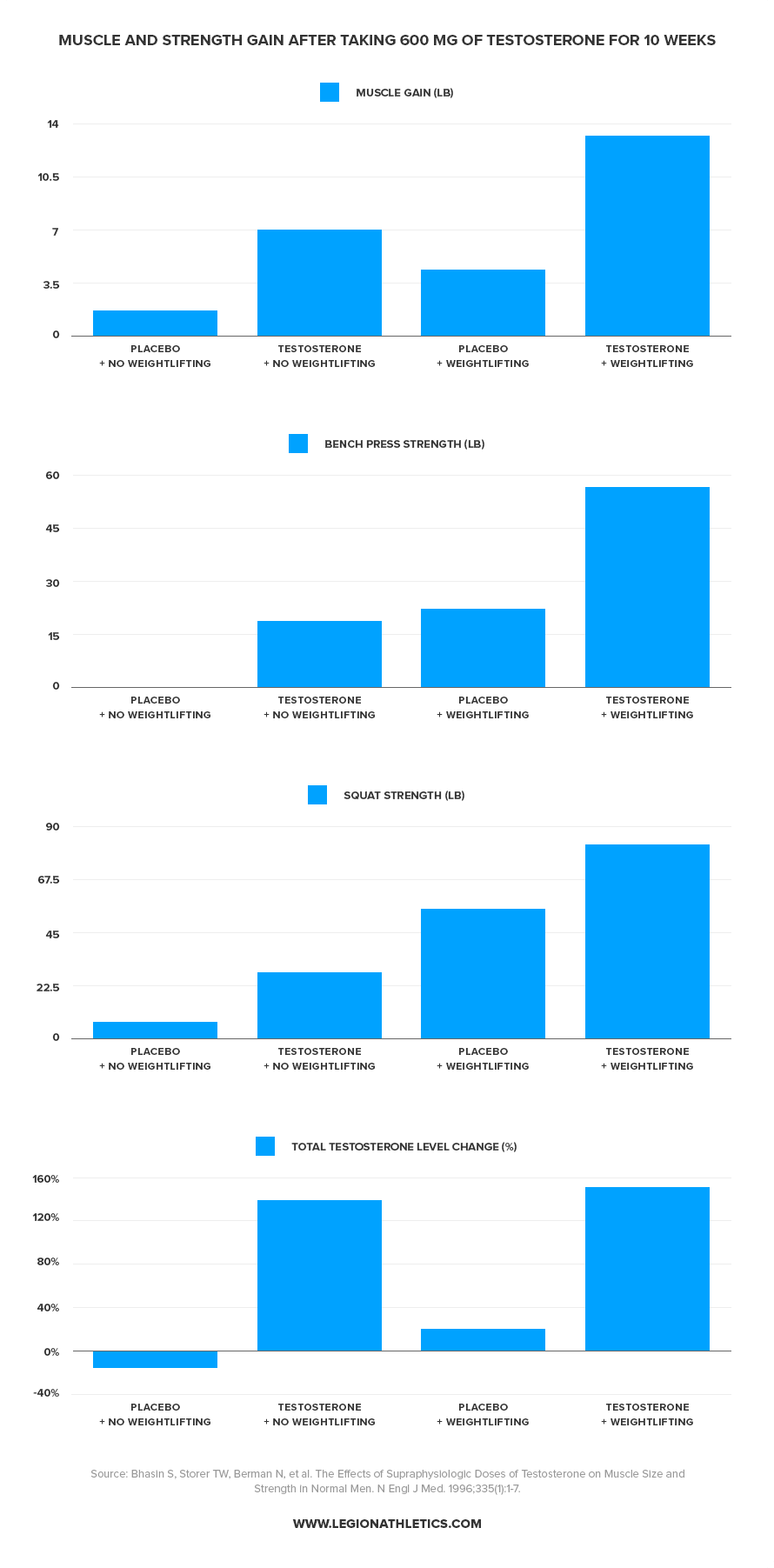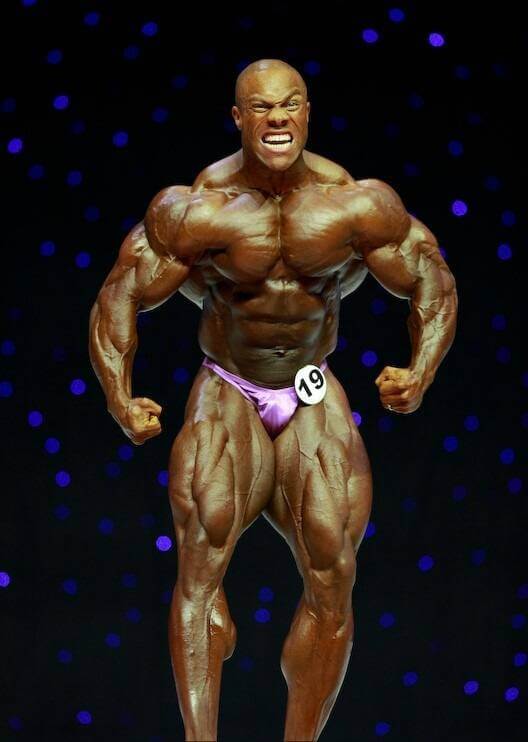Key Takeaways
- An anabolic steroid is a man-made substance that affects the body like testosterone, including increased muscle growth and recovery, strength, and leanness.
- Even a small dose of steroids can help you build muscle up to three times faster than you’d be able to naturally, while getting or staying lean.
- Despite what steroid users claim, these drugs come with many temporary and permanent side effects—keep reading to learn what they are, and whether the pros of steroids outweigh the cons.
Some say steroids are safe and awesome.
Others say they cause permanent damage to your body and can even be deadly.
Drug users often swear they’re not addicted and can quit at any point.
Others admit that life is just better on steroids and don’t plan on giving them up.
Many recreational bodybuilders claim steroids don’t make as big a difference as everyone thinks.
A quick look at professional fitness competitors and athletes, however, suggests otherwise.
My point is there’s a lot of mystery surrounding steroid use and even more confusion. Like most things health and fitness, opinions are all over the place.
Chances are you’re anti-steroid and haven’t ever seriously considered “pinning,” but given the prevalence of performance-enhancing drugs and the prospects of rapid and startling improvements to your body composition, you may toy with the idea in your fitness journey.
And understandably so.
When you’re giving everything you’ve got to your workouts and diet, but you’re barely moving the needle, a second surge of newbie gains can sound mighty enticing.
That’s why in the U.S. alone, at least a million guys and gals of all ages turn to the sauce every year to get bigger, leaner, and stronger faster, and these numbers are on the rise (and could be much higher in reality, as most people don’t want to admit to steroid use).
So, how helpful are steroids for gaining muscle and strength and losing fat?
How do they work?
And what are the side effects?
You’re going to learn the answers to all of those questions and more in this article.
By the end, you’ll know the truth about steroids so you can make an informed, prudent decision about whether to use them.
Before we get to the technical information, though, I’d like to make my position on steroids clear:
I’m mostly (but not completely) anti-steroid; I’ve never used them and never will; and I think most people don’t need steroids to achieve their goals.
Keep that in mind as you read the first part of this article, which may give you a bit of a chub for doing at least a cycle or two of #dedication.
Get through the rest of it before you run off to the juicehead in your local gym or head to the darknet market, though, because it’s not all angel farts and chocolate coins.
So, let’s start at the logical beginning: what are steroids?
- What Are Steroids and How Do They Work?
- How Effective Are Steroids?
- What Are the Side Effects of Steroids?
- How Much Muscle Can You Build Naturally?
- How Can You Tell if Someone Is On Steroids?
- Are There Natural Alternatives to Steroids?
- The Bottom Line on Steroids and Bodybuilding
Table of Contents
+
Want to listen to more stuff like this? Check out my podcast!
What Are Steroids and How Do They Work?

When we say “steroid,” we mean “anabolic steroid,” which is a man-made substance that affects the body like testosterone, including increased muscle growth and recovery, strength, and leanness.
Steroids accomplish this through different means, but the net result is the same: protein synthesis rates soar, or protein degradation rates plummet, or both, which results in rapid muscle gain.
Read: The Best Way to Stimulate Muscle Hypertrophy (Build Muscle)
The mechanisms whereby body fat levels are reduced or suppressed vary from drug to drug and aren’t worth diving into here, but know that fat loss is part of the “package” that steroids deliver, too.
While testosterone itself is the best known steroid, there are many others that are popular among athletes and bodybuilders, like . . .
- Nandrolone
- Stanozolol (Winstrol)
- Trenbolone
- Oxandrolone
- Deca Durabolin
- Dianabol
- Methandrostenolone
- Boldenone
- Oxymetholone
- Drostanolone
Each of these drugs has a unique profile in terms of potency, toxicity, side effects, and synergism. They, and others, are combined in various ways to create steroid “cycles” for different purposes and goals.
For example, if you were a competitive bodybuilder and wanted to add 20 pounds of muscle in your off season, your steroid cycle would differ greatly from when you’re cutting for a show.
For that, you would need to reduce body fat while preserving lean mass and increasing fullness, dryness, hardness, and separation.
At bottom, though, all of these drugs work together to increase muscle mass and reduce body fat levels.
Summary: An anabolic steroid is a man-made substance that affects the body like testosterone, including increased muscle growth and recovery, strength, and leanness, and different steroids can be combined to maximize these effects while minimizing unwanted side effects.
How Effective Are Steroids?
Many steroid users would like you to believe that their superhuman bodies are more a result of hard work than drugs, but this isn’t true.
Yes, it takes a lot of sweat to look like them, but it also takes a lot of drugs.
The reason for this is simple: You can only build so much muscle and get so lean naturally, and that’s not good enough for many fitness competitors, influencers, and fanatics. They want more size and strength and less fat—and will pay a high price to accomplish this.
To understand how big a difference steroids can make, let’s take a brief look at how powerful these drugs are.
In a review of the steroid literature conducted by scientists at Maastricht University, researchers found that during periods of ten weeks or fewer, the average muscle gains in people doing resistance training while on anabolic steroids ranged between 4 to 11 pounds.
The most impressive amount of muscle growth was nearly 16 pounds of lean mass gained in just six weeks of weightlifting with steroids—more than what natural guys will gain in their first six months of weightlifting.
What’s more, this study doesn’t represent the full potential of steroids, because it included recreational, novice drug users (who often don’t know what they’re doing) with more experienced and informed weightlifters.
When you look at just people who’ve perfected the process of using drugs, training, and diet to get bigger, leaner, and stronger, the results are even more impressive.
A good example of this is a study conducted by scientists at the University of Jyväskylä, where an elite bodybuilder allowed researchers to observe and inspect his body for a year.
During this period, the bodybuilder used steroids for all but four weeks, and the results were staggering: he gained about 15 pounds of muscle, increased his lower-body strength by about 16% and added an inch to his 25-inch quads and 17-inch biceps.
There’s more, too—his body fat didn’t budge throughout the entire process, remaining at about 8.5% the entire time.
Another validation of the effectiveness of steroids is a study conducted by scientists at the Charles R. Drew University of Medicine and Science, where they randomly assigned 43 men to one of four groups.
- Group one took a placebo and did no exercise.
- Group two took testosterone and did no exercise.
- Group three took a placebo and exercised.
- Group four took testosterone and exercised.
All groups were given a standardized diet to follow, and the people who exercised squatted and bench pressed three times per week for a total of twelve sets of six reps, with varying amounts of weights lifted in each workout. Muscle size was measured by MRI, and strength was determined by actual one-rep maximums.
As you can see, the results demonstrate by steroids are so popular:

The results are particularly mind-boggling when it came to muscle growth:
- The placebo group gained no muscle.
- The testosterone-only group gained an average of 6.6 pounds of muscle.
- The exercise-only group gained an average of 4.4 pounds of muscle.
- The testosterone and exercise group gained an average of 13 pounds of muscle.
Yes, you read that correctly.
The testosterone-only group gained more muscle than the guys weightlifting three times per week, and the testosterone-and-exercise group gained about three times as much muscle on average as the exercise-only folk.
Some people will try to argue that what we’re seeing here is increased water retention in the muscles registering as lean mass, but other research conducted by the same group shows otherwise, confirming that anabolic steroids increase muscle fiber growth.
Another thing to keep in mind is the men were given just 600 milligrams of testosterone per week, which is a beginner’s dosage by today’s standards.
Many guys are using multiple times that amount with multiple other drugs, and if you know what you’re doing, the more anabolics you take, the more muscle you gain.
Muscle and strength aren’t the only benefits of steroid use—they also help keep you lean.
Research shows that testosterone directly inhibits the creation of fat cells, which helps explain why higher levels of testosterone are associated with lower levels of body fat, and lower levels with higher body fat percentages.
And, as I’ve mentioned, that’s just testosterone. Several other steroids also promote a leaner, more muscular physique and, when combined properly, are incredibly powerful.
The bottom line?
Steroids are impressively effective at increasing muscle growth and strength and promoting leanness. You don’t need drugs to build a great body, but they make it a much easier and faster process.
Summary: Even a small dose of steroids allows you to gain muscle and strength two to three times faster than you could naturally, and raises your absolute ceiling for muscle growth far above what your genes would otherwise allow.
What Are the Side Effects of Steroids?

Steroids may not be as risky as some people think, but anyone using them in the belief that they’re safe if managed well is whistling past the graveyard.
To start, research shows that some side effects of steroid usage are reversible, and some aren’t. Permanent damage is possible.
For example, correctible changes include testicular atrophy (shrinking), acne, cysts, oily hair and skin, elevated blood pressure and “bad” cholesterol levels, increased aggression, and lowered sperm count. Irreversible injury includes male-pattern baldness, heart dysfunction, liver disease, acne scars (if any), and gynecomastia (breast development).
Some of the “reversible” side effects, like testicular atrophy, may also become permanent after years of steroid use.
Moreover, we don’t know what the long-term side effects of many steroids are, because the research would never get past an ethics board. That means all we can do is observe what happens to the people using these drugs. I wouldn’t recommend being one of those case studies.
Also, you can never be sure what you’re putting into your body when you take steroids. Some are made by pharmaceutical companies, but many more are produced in underground labs by amateur chemists, and that means you have to ask yourself a serious question before hitting the needle: how comfortable are you handing your health over to anonymous criminals?
Another major downside to steroids is the risk of biological and psychological addiction.
For instance, one study found that 30% of steroid users developed a dependence syndrome, and if you speak to enough honest drug users, you’ll hear about the addictive properties of these drugs.
If I had a nickel for every time I’ve heard a long-term steroid user say he’d intended on doing “just one cycle,” I’d be making money in a very odd way.
Too many told themselves they would just “try it out” to “speed things up a bit”—and wound up on the bike for the long haul.
I used to train with a guy named George who had this problem. He didn’t like that he was on steroids but loved being on steroids. In his own words, he worried about his health, but when he was on cycle, his energy, confidence, and drive surged. He didn’t need as much sleep, and he was strong, powerful, and tireless in the gym. He felt invincible.
When he went off drugs, though, it let all the air out of his balloon. He dwindled to a shadow of his “superhero” self and felt stuck in second gear, which drove him back time and again. George’s story is typical, too. And one that I don’t want to experience myself.
Some people argue that you can mitigate, or even eliminate, the risks of steroid use by intelligently overseeing your drug cycles and health. This is a fool’s paradise.
You can reduce the risk of catastrophes by being smart, but you can’t escape the reality that anabolics put a lot of stress on the body. Every time you inject or swallow them, there’s a chance something can go very wrong.
Another mirage that lures many people into using steroids is the idea that you can do a cycle or two to rapidly increase strength and muscularity and then maintain your newfound gains naturally.
In reality, the drugs giveth and taketh away—most of the muscle and strength you gain on steroids vanishes soon after you stop taking them. This isn’t surprising. You’re artificially raising your hormone levels to supernatural levels to achieve supernatural results in your physique, and when your hormone levels return to normal, so does your physique.
The mechanics of this are fairly simple.
After you stop taking steroids, your natural testosterone levels are more or less nonexistent, and it takes months for them to recover to normal levels. And while your testosterone levels are bottomed out, you lose muscle and your performance tanks.
Many bodybuilders believe they can avoid this fate by using a proper post cycle therapy (PCT) regimen. This involves taking more drugs, like human chorionic gonadotropin (HCG) and estrogen blockers to stimulate the body’s natural production of testosterone and prevent estrogen levels from rising too high.
This can help restore your hormonal health faster than if you quit steroids cold turkey, but here’s the kicker: You can’t take drugs to reach or exceed your natural genetic potential for muscle growth and then maintain that physique without continuing to take steroids. It simply doesn’t work.
Some people also say you can mitigate the downsides of steroid use by weaning off them slowly, but this actually increases the chances of muscle loss.
As long as you’re taking enough steroids to be effective, they’ll also be enough to shut down your body’s natural production of testosterone. By reducing the dose slowly, your muscles will just shrink slowly, taking even longer to return to natural normalcy.
Read: How to Actually Increase Your Testosterone (and How Not to)
For all of these reasons, I don’t use steroids and don’t recommend them. Unless you’re a professional athlete or actor, with your livelihood directly tied to your physical performance or appearance, the risks far outweigh the rewards.
Summary: Steroids come with a long list of temporary side effects including testicular atrophy (shrinking), acne, cysts, oily hair and skin, elevated blood pressure and “bad” cholesterol levels, increased aggression, and lowered sperm count, as well as permanent ones including male-pattern baldness, heart dysfunction, liver disease, acne scars (if any), and gynecomastia (breast development).
How Much Muscle Can You Build Naturally?
Some people say that with enough hard work, patience, and food, you can get as big and strong as you want.
As you now know, most of these people are also on steroids.
The home truth is that we can only gain so much muscle naturally, and no amount of training, eating, or supplementing can raise that ceiling.
It’s impossible to calculate or predict the ceiling precisely, but there are several research-backed methods you can use to gain a fairly accurate estimate of how jacked you can probably get.
What’s more, these methods also double as tools for spotting secret steroid users (more on this in a moment).
One of the simplest and easiest methods for calculating your natural potential for muscle gain is known as the fat-free mass index (FFMI).
FFMI is a measurement of how much muscle you have per unit of height.
It’s calculated by dividing your fat-free mass (your total body weight minus the weight of your body that’s fat) in kilograms by your height in meters squared, and you can find yours by plugging your height, weight, and body fat percentage into this calculator:
As there’s a correlation between height and potential muscularity, and as organ weight doesn’t vary much from person to person, you’d expect to see a higher average FFMIs among steroid users than non-users as well as FFMIs among steroid users that are simply unobtainable naturally.
And that’s exactly what research has shown.
In the most famous and comprehensive study on FFMI and steroids, scientists at McLean Hospital calculated the FFMI of 157 young male athletes from around the Los Angeles and Boston areas, including several elite bodybuilders and world-record holding strongmen, as well as some gents undergoing a testosterone injection study.
Of these guys, 31 admitted to taking steroids in the past, 52 admitted to taking steroids within the previous year, and 74 claimed they had never taken steroids. The researchers also had everyone take a urine test to at least attempt to partially validate their claims.
After analyzing the data, the scientists found the steroid users had an average FFMI of 24.8 while the purported non-users averaged at 21.8. Another significant finding was not a single natural participant had an FFMI over 25, whereas many “enhanced” ones did.
This has led many people to declare 25 as the FFMI ceiling for natural (male) weightlifters. (There’s no similar research available on women, but it’s fair to assume their ceiling would be significantly lower.)
Others, however, point out that this is too simplistic because it doesn’t account for differences in height. The taller someone is, they say, the wider and thicker they are as well, and if you look at the data in the study, you’ll see that the taller athletes naturally had a higher FFMIs regardless of how much muscle they had gained through training.
They’re right. Here’s a chart of the heights and FFMIs of each of the participants:

As you can see by the line in the middle of the chart, as height increased, so did FFMI regardless of steroid use or not.
The researchers were aware of this as well, however, which is why they normalized the data to the average height of the participants, 5’11. This allowed them to more or less remove height as a potential confounder in determining the relationship between steroids and FFMI.
After normalizing the data and reassessing it, the scientists found that every single natural athlete had a normalized FFMI of 24.9 or less, whereas about half of the steroid users had a normalized FFMI of 25 or greater.
You can learn more about the arguments for and against using FFMI to spot steroid users in this article, but the long story short is this:
- If someone’s normalized FFMI is over 25, it’s almost certain they’re taking or have taken steroids.
- If someone’s normalized FFMI is between 24 and 25, then it’s likely they’re taking or have taken steroids.
- If someone’s normalized FFMI is between 22 and 23 and they’ve been training consistently for 3+ years, they may be natural.
- If someone’s normalized FFMI is between 21 and 22, they may be natural as well.
- If someone’s normalized FFMI is between 18 and 21, they likely don’t even lift so who cares. 🙂
Now, let’s put some visuals to various FFMIs. I’ll start with myself.
I’m 6’1, and about 9% body fat at 192 pounds, and I’ve never used steroids:
View this post on Instagram
And here’s a picture of well-known fitness model and competitor Jaco De Bruyn:

Jaco’s also 6’1 and competes at 4 to 5% body fat at about 194 pounds, putting his FFMI around 25. Jaco says he doesn’t use steroids.
And here’s Phil Heath, the current Mr. Olympia, who’s 5’9 and competes at 4 to 5% body fat at about 250 pounds, making his FFMI about 35:

Phil claim’s he’s natural too.
And, just for comparison’s sake, here’s a shot of the legendary Frank Zane, who has been open about his steroid use:

Frank is 5’9 and competed at about 5 to 6% body fat at about 185 pounds, pegging his FFMI at about 26 in his prime.
And here’s The Oak, who has also admitted to using steroids throughout his bodybuilding career:

Arnold is 6’2 and stepped on stage at about 5 to 6% body fat at about 235 pounds, which gave him an FFMI of about 30.
So, as you can see, once your FFMI starts approaching 25, every uptick equates to a pretty significant change in terms of your overall physique. And in terms of how much muscle you can build as a natural weightlifter, it’s safe to assume that 25 is going to be your FFMI ceiling.
Aside from FFMI, there’s another, more precise way of determining exactly how much muscle you can build naturally: measuring the size of your wrists and ankles.
Strange as it may seem, the best predictor of your genetic ceiling for muscle growth seems to be the size of our skeleton, which you can estimate using your wrist and ankle circumference measurements.
Once you have these measurements, you can plug them into a calculator that spits out a highly-accurate estimate of your maximum genetic potential whole-body muscle gain, as well as the size of different muscle groups.
You can read this article to learn more about the science behind this method, but if you just want to know your results, plug your wrist and ankle measurements into this calculator:
Want to save your results?
Enter your email so we can send them to you.
If you’re like most people, you’re probably pleased with the results.
Many people think they’ve hit their genetic potential for muscle gain when they’ve been plateaued for a few months or years, when in reality, they still have plenty of room to grow. The best solution isn’t steroids, but patience and proper diet and training.
(And if you’d like specific advice about what diet to follow to reach your fitness goals, take the Legion Diet Quiz.)
Read these articles to learn what this involves:
⇨ The 12 Best Science-Based Strength Training Programs for Gaining Muscle and Strength
⇨ The Ultimate Guide to Bulking Up (Without Just Getting Fat)
⇨ 6 Proven Ways to Break Through Weightlifting Plateaus
Summary: You can roughly predict your maximum natural ceiling for muscle growth by calculating your FFMI, and you can more precisely predict your muscle-building potential by plugging your wrist and ankle measurements into the Legion Natural Muscular Potential Calculator.
How Can You Tell if Someone Is On Steroids?
You want to know how to identify likely drug users so they can’t screw up your progress with bad advice, or your expectations and standards with their outstanding physiques.
You’re probably on social media, so you know what I’m talking about.
Around every corner is another influencer who’s willing to subject his body to a regular regimen of dangerous chemicals to get followers to peddle products and services to.
“LOOK AT ME!” they cry. “LOOK AT MY ABS AND BICEPS AND SHIT! DON’T YOU WANT TO LOOK LIKE THIS? FUCK YEAH YOU DO! JUST CLICK THE LINK IN MY BIO TO PAY ME $97.97 IN 79 EASY HOURLY INSTALLMENTS AND I WILL SHOW YOU HOW!!!!!”
This isn’t just dishonest; it’s harmful.
First, drug users who’ve had little experience or results as drug-free lifters often give bad advice to natural weightlifters.
With the right steroids, you can get a lot wrong in the kitchen and gym and still build an extraordinary body.
For example, you can train more frequently and intensely, recover wonderfully, and pay less attention to your diet . . . and stay absolutely shredded the entire time.
Remember the bodybuilder who used steroids to gain 15 pounds of muscle in a year while staying at 8.5% body fat?
He reported eating between 2,300 and 3,600 calories per day throughout the year, but didn’t meticulously track his calories and macros, so it’s hard to know how much he actually ate.
Many people on gear don’t know or care about the monumental advantages they enjoy, though, so when they tell others to eat and train as they do, these people get nowhere near the same results.
Many then assume they just don’t have the genetics for a great physique, and they either give up, relegate themselves to mediocrity, or, ironically, turn to steroids.
A few “enhanced” trainers and coaches out there understand this and know how to change routines and diets for natural weightlifters, but they’re rare. And even if a “fake natty” gives good advice and rationalizes that this “noble end” justifies the means, it’s still immoral to lie about using drugs to get a body that wins people’s attention, trust, and business.
Second, many steroid users create false expectations that will lead to disappointment and failure for others. This is especially true of those who say anyone can get huge and shredded with enough hard work and #dedication.
We natural weightlifters can look great, but no matter what we do, we will never, ever look like a lot of what we see on Instagram. We can get big, lean, and strong, but there’s a level of muscularity, hardness, leanness, dryness, and fullness that no amount of natural bodybuilding can achieve.
So, for all of these reasons, it’s worth learning how to identify steroid users.
The biggest red flags are . . .
- They have a normalized fat-free max index of 25 or more.
- They’re very big, very lean, and very strong.
- They suddenly got way stronger.
- They have a massive upper chest, shoulders, and traps.
- They’re shredded, dry, and full, with amazing muscle separation.
- They stay extremely lean, full, and dry year round.
- They have excellent overall development and proportions.
- They have bad acne and male pattern baldness.
If you want to learn more about the rationale behind each of these methods, read this article:
Read: 8 Reliable (and Evidence-Based) Ways to Tell If Someone Is “Natty” or Not
Summary: It’s worth learning how to identify secret steroid users so that you don’t let their appearance give you false expectations or their advice lead you astray in the kitchen and in the gym.
Are There Natural Alternatives to Steroids?

No.
Forget what the supplement companies tell you—there are NO natural substances that even come close to steroids in any way, shape, or form.
“Test boosters” are worthless and HGH boosters belong in the trash can with them.
Read: Does Tribulus Terrestris Boost Testosterone? What 28 Studies Say
Some people think instead of boosting testosterone levels, they can short-circuit muscle growth by taking substances that reduce estrogen levels. This is a fool’s errand.
Not only have estrogen-blocking drugs never been shown to improve muscle growth, there’s good reason to think they may actually impede it.
The only supplement that will help you gain noticeably more muscle and strength is creatine. And even then, it only works by helping your muscles contract a bit more efficiently during hard workouts—it doesn’t directly increase muscle growth on its own.
There are other synthetic drugs like SARMs and prohormones that can mimic some of the effects of steroids, but these aren’t natural or, in (in the case of SARMs) necessarily safer.
Read: This Is Everything You Need to Know About SARMs
The bottom line is that any substance that’s powerful enough to produce results similar to steroids will also produce similar side effects. That’s just the nature of muscle-building drugs.
Summary: There are no natural supplements or drugs that even come close to replicating the effects of steroids.
The Bottom Line on Steroids and Bodybuilding
Steroids are becoming more and more popular in the fitness world, but most people know very little about these drugs.
Simply put, an anabolic steroid is a man-made substance that affects the body like testosterone, helping you gain muscle and strength, recover faster after workouts, and lose body fat.
Although some steroid users would have you believe their physiques are more the result of hard work than their chemical assistance, research shows this isn’t true.
Even a small dose of steroids allows you to gain muscle and strength two to three times faster than you could naturally, and raises your absolute ceiling for muscle growth far above what your genes would otherwise allow.
Others think that, if properly managed, they can get the benefits of steroids without any negative side effects. This is also foolish.
Steroids come with a long list of temporary and permanent side effects that range from the cosmetic (acne, cysts, oily hair and skin, male-pattern baldness, breast development) to the concerning (elevated blood pressure and “bad” cholesterol levels, increased aggression, lowered sperm count) to the life-threatening (heart dysfunction, liver disease, cancer).
No matter what you do in the gym and in the kitchen, there is a limit to how much muscle you can gain naturally, and it’s probably a lot lower than what you might expect based on what you see on Instagram.
That said, even if you haven’t gained much size or strength to speak of for a while, you may still have significant room for improvement.
You can roughly predict your maximum natural ceiling for muscle growth by calculating your FFMI, and you can more precisely predict your muscle-building potential by plugging your wrist and ankle measurements into the Legion Natural Muscular Potential Calculator.
It’s also worth learning how to identify secret steroid users so that you don’t let their appearance give you false expectations or let their advice distract you from what really matters.
Finally, there are no natural supplements or drugs that even come close to replicating the effects of steroids.
The only way to reach your genetic potential for muscle gain is to follow a well-designed workout and diet program, get plenty of sleep and minimize stress, and take a few supplements that will make the process slightly faster and more efficient.
If you want to learn more about what this entails, check out these articles:
⇨ The 12 Best Science-Based Strength Training Programs for Gaining Muscle and Strength
⇨ The Best Way to Stimulate Muscle Hypertrophy (Build Muscle)
⇨ The Best Way to Gain Muscle Without Getting Fat
⇨ How Much Protein You Should Eat to Build Muscle
What’s your take on steroids? Have anything else to share? Let me know in the comments below!
Scientific References +
- Kyle, U. G., Morabia, A., Schutz, Y., & Pichard, C. (2004). Sedentarism affects body fat mass index and fat-free mass index in adults aged 18 to 98 years. Nutrition, 20(3), 255–260. https://doi.org/10.1016/j.nut.2003.11.019
- Kouri, E. M., Pope, H. G., Katz, D. L., & Oliva, P. (1995). Fat-free mass index in users and nonusers of anabolic-androgenic steroids. Clinical Journal of Sport Medicine, 5(4), 223–228. https://doi.org/10.1097/00042752-199510000-00003
- Griffiths, S., Henshaw, R., McKay, F. H., & Dunn, M. (2017). Post-cycle therapy for performance and image enhancing drug users: A qualitative investigation. Performance Enhancement and Health, 5(3), 103–107. https://doi.org/10.1016/j.peh.2016.11.002
- Kanayama, G., Brower, K. J., Wood, R. I., Hudson, J. I., & Pope, H. G. (2009). Anabolic-androgenic steroid dependence: An emerging disorder. In Addiction (Vol. 104, Issue 12, pp. 1966–1978). Addiction. https://doi.org/10.1111/j.1360-0443.2009.02734.x
- Kanayama, G., Hudson, J. I., & Pope, H. G. (2009). Features of men with anabolic-androgenic steroid dependence: A comparison with nondependent AAS users and with AAS nonusers. Drug and Alcohol Dependence, 102(1–3), 130–137. https://doi.org/10.1016/j.drugalcdep.2009.02.008
- Hartgens, F., & Kuipers, H. (2004). Effects of androgenic-anabolic steroids in athletes. In Sports Medicine (Vol. 34, Issue 8, pp. 513–554). Sports Med. https://doi.org/10.2165/00007256-200434080-00003
- van Amsterdam, J., Opperhuizen, A., & Hartgens, F. (2010). Adverse health effects of anabolic-androgenic steroids. Regulatory Toxicology and Pharmacology, 57(1), 117–123. https://doi.org/10.1016/j.yrtph.2010.02.001
- Storer, T. W., Magliano, L., Woodhouse, L., Lee, M. L., Dzekov, C., Dzekov, J., Casaburi, R., & Bhasin, S. (2003). Testosterone dose-dependently increases maximal voluntary strength and leg power, but does not affect fatigability or specific tension. Journal of Clinical Endocrinology and Metabolism, 88(4), 1478–1485. https://doi.org/10.1210/jc.2002-021231
- Singh, R., Artaza, J. N., Taylor, W. E., Braga, M., Yuan, X., Gonzalez-Cadavid, N. F., & Bhasin, S. (2006). Testosterone inhibits adipogenic differentiation in 3T3-L1 cells: Nuclear translocation of androgen receptor complex with β-catenin and T-cell factor 4 may bypass canonical Wnt signaling to down-regulate adipogenic transcription factors. Endocrinology, 147(1), 141–154. https://doi.org/10.1210/en.2004-1649
- Forbes, G. B. (1985). The effect of anabolic steroids on lean body mass: The dose response curve. Metabolism, 34(6), 571–573. https://doi.org/10.1016/0026-0495(85)90196-9
- Sinha-Hikim, I., Artaza, J., Woodhouse, L., Gonzalez-Cadavid, N., Singh, A. B., Lee, M. I., Storer, T. W., Casaburi, R., Shen, R., & Bhasin, S. (2002). Testosterone-induced increase in muscle size in healthy young men is associated with muscle fiber hypertrophy. American Journal of Physiology - Endocrinology and Metabolism, 283(1 46-1). https://doi.org/10.1152/ajpendo.00502.2001
- Bhasin, S., Storer, T. W., Berman, N., Callegari, C., Clevenger, B., Phillips, J., Bunnell, T. J., Tricker, R., Shirazi, A., & Casaburi, R. (1996). The effects of supraphysiologic doses of testosterone on muscle size and strength in normal men. New England Journal of Medicine, 335(1), 1–7. https://doi.org/10.1056/NEJM199607043350101
- Alen, M., & Hakkinen, K. (1985). Physical health and fitness of an elite bodybuilder during 1 year of self-administration of testosterone and anabolic steroids: A case study. International Journal of Sports Medicine, 6(1), 24–29. https://doi.org/10.1055/s-2008-1025808
- Hartgens, F., & Kuipers, H. (2004). Effects of androgenic-anabolic steroids in athletes. In Sports Medicine (Vol. 34, Issue 8, pp. 513–554). Sports Med. https://doi.org/10.2165/00007256-200434080-00003
- Pereira, E., Moyses, S. J., Ignácio, S. A., Mendes, D. K., da Silva, D. S., Carneiro, E., Hardy, A. M. T. G., Rosa, E. A. R., Bettega, P. V. C., & Johann, A. C. B. R. (2019). Anabolic steroids among resistance training practitioners. PLOS ONE, 14(10), e0223384. https://doi.org/10.1371/journal.pone.0223384
- Baker, J. S., Graham, M., & Davies, B. (2006). Gym users and abuse of prescription drugs. In Journal of the Royal Society of Medicine (Vol. 99, Issue 7, pp. 331–332). Royal Society of Medicine Press. https://doi.org/10.1258/jrsm.99.7.331










